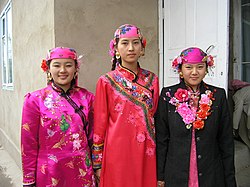Dungans
 Dungan girls in Shor-Tyube, Kazakhstan |
|
| Total population | |
|---|---|
| 110,024 | |
| Regions with significant populations | |
|
|
64,565 |
|
|
36,900 |
|
|
801 |
|
|
6,000 |
|
|
5,300 |
|
|
1,900 |
|
|
133 |
| Languages | |
| Dungan | |
| Religion | |
| Islam | |
| Related ethnic groups | |
| Hui, Chinese people | |
| Dungan people | |||||||
| Chinese name | |||||||
|---|---|---|---|---|---|---|---|
| Traditional Chinese | 東干族 | ||||||
| Simplified Chinese | 东干族 | ||||||
|
|||||||
| Dunganese name | |||||||
| Dungan | Хуэйзў Доңганзў |
||||||
| Xiao'erjing | حُوِ ذَو | ||||||
| Romanization | Huejzw | ||||||
| Hanzi | 回族 | ||||||
| Russian name | |||||||
| Russian | Дунгане | ||||||
| Transcriptions | |
|---|---|
| Standard Mandarin | |
| Hanyu Pinyin | Dōnggānzú |
Dungan (Dungan: Хуэйзў, Xuejzw/Huizu, Xiao'erjing: حُوِ ظُ; simplified Chinese: 东干族; traditional Chinese: 東干族; pinyin: Dōnggān zú; Wade–Giles: Tung1kan1-tsu2; Xiao'erjing: دْوقًا ظُ; Russian: Дунгане, Dunganě; Kyrgyz: Дунгандар, Dunğandar, دۇنغاندار) is a term used in territories of the former Soviet Union to refer to a Muslim people of Chinese origin. Turkic-speaking peoples in Xinjiang Province in China also refer to members of this ethnic group as Dungans. In both China and the former Soviet republics where they reside, however, members of this ethnic group call themselves Hui.
In the censuses of the now independent states of the former Soviet Union, the Dungans, who are enumerated separately from Chinese, can be found in Kazakhstan (36,900 according to the 1999 census), Kyrgyzstan (58,409 according to the 2009 census), and Russia (801 according to the 2002 census).
In the Ferghana Valley, the first Dungans to appear in Central Asia originated from Kuldja and Kashgar, as slaves captured by raiders; they mostly served in private wealthy households. After the Russians conquered Central Asia in the late 19th century and abolished slavery, most female Dungan slaves remained where they had originally been held captive, Russian ethnographer Validimir Petrovich Nalivkin and his wife said that "women slaves almost all remained in place, because they either were married to workers and servants of their former owners, or they were too young to begin an independent life". Dungan women slaves were of mean status, and not regarded highly in Bukhara.
...
Wikipedia
